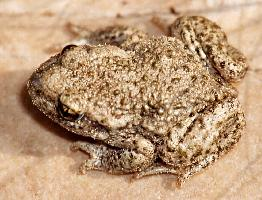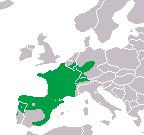
Váhy a míry
| Délka | od 4 do 5 cm |
|---|
Stav ohrožení
| Ohrožen |
Popis zvířete
The Common Midwife Toad (Alytes obstetricans) is a fascinating and somewhat peculiar amphibian native to Western Europe. This species is distinguished not only by its unique reproductive behaviors but also by its distinctive physical characteristics and habitat preferences.Physically, the Common Midwife Toad is relatively small, with adults typically reaching lengths of about 4 to 5 centimeters. They possess a robust and somewhat rounded body shape, which is covered in a skin that can range in color from a dull grayish-brown to a more vibrant yellowish-brown. This skin is textured with warts and granules, giving it a rough appearance. The toad's underbelly, in contrast, is smoother and usually lighter in color. One of its most distinctive features is the presence of vertical pupils in its eyes, a characteristic it shares with many other toad species. Additionally, males and females can often be differentiated by the size of their forelimbs and the presence of nuptial pads on the males, which are used during mating.
The Common Midwife Toad's name is derived from its unique reproductive behavior. Unlike most amphibians, the male of the species plays an active role in the care of the offspring. After the female lays her eggs, the male fertilizes them and then proceeds to wrap the strings of eggs around his hind legs. He carries them with him for several weeks, hence the name "midwife," until they are ready to hatch. During this period, the male diligently keeps the eggs moist by seeking out damp locations and even submerging himself in water if necessary. This unusual parental investment helps protect the eggs from predation and desiccation.
The habitat of the Common Midwife Toad is varied, but they show a preference for temperate forests, meadows, and scrublands, often in close proximity to slow-moving or stagnant bodies of water which are essential for the hatching of their eggs. They are also commonly found in human-modified landscapes such as gardens and agricultural areas, where they can find ample hiding spots and breeding sites.
Common Midwife Toads are nocturnal and spend much of the day hidden under rocks, leaf litter, or burrowed into the soil. At night, they emerge to forage for a diet that primarily consists of small invertebrates, such as insects, worms, and spiders. Their own predators include snakes, birds, and small mammals, against which they have developed a defensive mechanism: when threatened, they can secrete a mildly toxic substance from their skin to deter would-be attackers.
Despite facing threats from habitat loss, pollution, and disease, the Common Midwife Toad is currently classified as Least Concern by the International Union for Conservation of Nature (IUCN), indicating that it does not currently face an immediate threat of extinction. However, continued vigilance and conservation efforts are necessary to ensure that this unique species remains a part of our natural heritage.
Mapa výskytu

Nové fotografie zvířat
Top 10 zvířat
- Chinese water dragon (Physignathus cocincinus)
- Galápagos tortoise (Geochelone nigra complex)
- Dolphin gull (Leucophaeus scoresbii)
- Japanese macaque (Macaca fuscata)
- Colombian red howler (Alouatta seniculus)
- Sea urchins (Echinoidea)
- Moustached guenon (Cercopithecus cephus)
- Diana monkey (Cercopithecus diana)
- Common reed warbler (Acrocephalus scirpaceus)
- Common house mosquito (Culex pipiens)